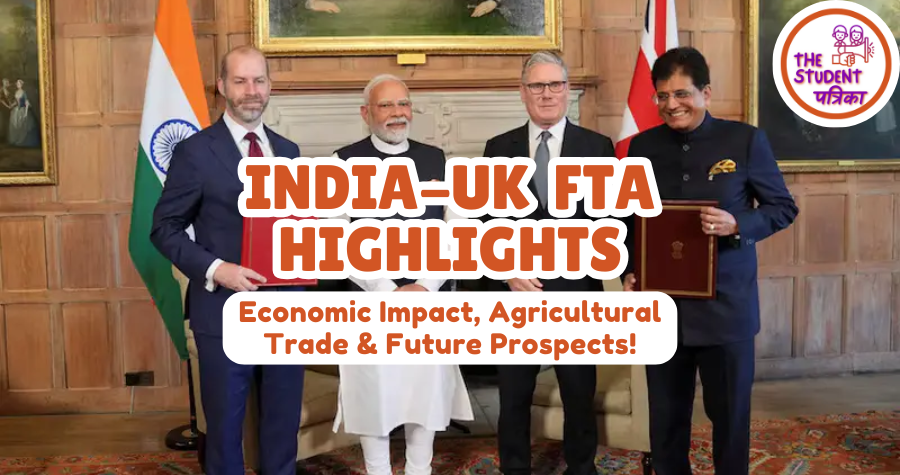
What Is a Free Trade Agreement (FTA)?
A Free Trade Agreement (FTA) is a treaty between two or more countries aimed at reducing or eliminating trade barriers—such as tariffs, quotas, or other restrictions—on goods and services across borders. FTAs typically offer preferential access, helping accelerate trade, investment, and economic cooperation.
Background & Timeline:
-
Negotiations began in January 2022, progressing through 15 rounds of talks over three and a half years.
-
On 6 May 2025, both governments reached an agreement in principle, along with a Double Contribution Convention addressing social security for Indian workers in the UK.
-
The formal signing occurred on 24 July 2025, during PM Narendra Modi’s visit to the UK, alongside UK Premier Keir Starmer.
-
Indian Commerce Minister Piyush Goyal and UK counterpart Jonathan Reynolds signed the agreement in the presence of both prime ministers.
Key Highlights of the Deal:
1. Tariff Reductions
-
India → UK: Elimination of duties on 99% of Indian exports (textiles, leather, footwear, engineering goods).
-
UK → India: Tariffs on ~90% of British exports reduced significantly, from 15% to 3% on average; luxury goods like Scotch whisky and cars get marked cuts over time (e.g. whisky duty cut from 150% to 75%, later to 40%).
2. Trade Expansion Targets
-
Bilateral trade projected to rise from US $60 billion (2024) to US $120 billion by 2030, with even larger gains by 2040 (estimated economic benefit of £25.5 billion).
3. Market Access & Hire Mobility
-
Indian exporters gain quota access into UK markets for goods like electric vehicles, textiles, gems, and auto components.
-
Service mobility eased: Professionals, business visitors, musicians, chefs, and yoga instructors gain recognised access; Social Security Convention to prevent double contributions.
4. Investments & Jobs
-
Deal expected to unlock nearly £6 billion in bilateral investment and support export-driven job creation, especially in textiles, engineering, and dairy.
-
This tariff relief is expected to boost Indian agricultural exports by at least 20% within three years, aligning with India’s goal of achieving $100 billion in agri-exports by 2030. The marine and fisheries sector, worth ₹60,000 crore, is poised for rapid expansion into the UK's $5.4 billion seafood import market
5. Exemptions
-
Key sensitive sectors like agriculture, financial/legal services, and carbon border tax mechanisms remain largely outside the deal.
-
Under the agreement, over 95% of Indian agricultural and processed food exports—including staples like turmeric, pulses, pickles, mango pulp, spices, tea, coffee, fruits, and processed foods—will enter the UK without any import tariffs. Marine exports such as shrimp, tuna, and fishmeal also now enjoy zero-duty access.
Strategic Significance:
-
India's First Major FTA Outside Asia: Marks India’s first comprehensive FTA with a European country, boosting global trade credentials.
-
UK’s First Major Post-Brexit Deal: Described by UK officials as Britain’s most significant agreement since leaving the EU.
-
Supporting ‘Make in India’: Enhanced export access for Indian manufacturers contributes to expanding production, investment, and industry growth.
-
Global Supply Chains & Innovation: Encourages movement of goods, services, technology, and professionals between the two economies.
Sector-Wise Impacts:
| Sector | Benefits & Concerns |
|---|---|
| Textiles & Leather | Tariff-free exports to UK, boosting employment in export hubs |
| Automobiles & EVs | Gradual duty reductions; quota access into UK |
| Whisky & Luxury Goods | Reduced import tariffs in India—from 150% to 75% and then to 40% |
| IT & Services | Easier visa provisions for Indian tech professionals and others |
| Investments | Potential £6 bn inflows in sectors like AI, aerospace, dairy |
| MSMEs | Opportunity to scale via duty-free access, though compliance costs remain |
Importance from an Economic Diplomacy Lens
-
Aligns with India’s goal to become a $5 trillion economy by expanding global trade.
-
Enhances India–UK strategic ties across trade, climate cooperation, security, and higher education.
-
Offers a template for India's future FTAs—balancing liberalization with protection of sensitive sectors.
The India–UK Free Trade Agreement 2025 marks a quantum leap in bilateral economic ties. With near-zero duties on major exports, expanded market access, and easier professional mobility, the deal is expected to transform trade dynamics and support India’s shift toward export-led growth.
At Student Patrika, we simplify complex policies and global developments so you can stay informed, exam-ready, and future-focused. Want more such updates with real impact?
Bookmark our website for daily insights.
Write for us and share your voice: Guidelines to Contribute










